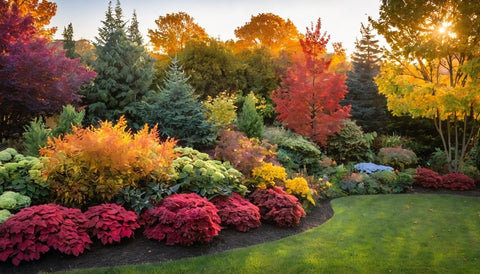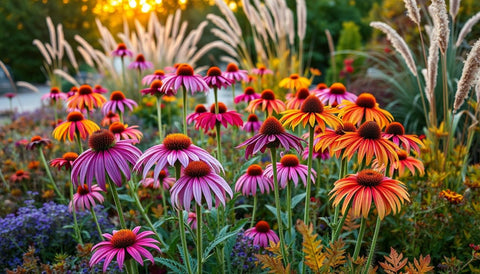Introduction
Fall is a magical time when nature paints itself in vibrant hues of red, orange, and gold. There's just something about a landscape bathed in these colors that lifts the spirit. But did you know that you can achieve this stunning autumn display using native shrubs? Not only do they enhance your garden's aesthetic, but they also contribute positively to local ecosystems. In this guide, we'll delve into the best native shrubs for fall color, planting tips, and how to maintain these beauties.
The Significance of Native Shrubs
Native shrubs are plants that naturally grow in your region without human intervention. Their significance goes beyond aesthetics; they're crucial for local biodiversity, supporting wildlife like pollinators and birds. Additionally, they're adapted to local soil and climate conditions, which makes them generally low maintenance. Imagine having a garden that's not only beautiful but also a haven for local wildlife!

Understanding Autumn Foliage
So, why do leaves change color in the fall? The brilliant shades we admire come from pigments in the leaves, responding to changes in temperature, light, and moisture. When nights are cool and days are sunny, the process of chlorophyll breakdown reveals the vibrant reds and yellows beneath. Incorporating shrubs that excel during this season can offer a stunning spectacle in your yard.
Top Native Shrubs for Fall Color
Serviceberry (Amelanchier spp.)
Serviceberry is truly a multi-talented shrub. In spring, it dazzles with white blossoms, transitioning to lush green leaves before transforming into a brilliant mix of orange and red in the fall. Plus, its berries are a delightful snack for birds and humans alike!
Red Twig Dogwood (Cornus sericea)
With vibrant red stems that shine even in winter, the Red Twig Dogwood is a standout choice. Its green leaves turn a radiant yellow and red in the fall, providing a stunning backdrop for any garden setting.
Sumac (Rhus spp.)
This hardy shrub contributes a splash of vivid scarlet and brilliant orange to your landscape. Sumac isn’t just a pretty face – its unique fruit clusters attract wildlife, making it as beneficial as it is beautiful.

Oak Leaf Hydrangea (Hydrangea quercifolia)
Boasting distinctive oak-like leaves, this shrub showcases rich shades of burgundy and bronze come autumn. Not only do its colors resonate with the fall palette, but its textured leaves add depth and elegance to your garden.
Spicebush (Lindera benzoin)
Spicebush is like autumn in a shrub. Its leaves blushing in golden yellows are mouthwatering, and they even emit a delightful aroma when crushed – talk about a sensory experience in your garden!
Ninebark (Physocarpus opulifolius)
With unique peeling bark and vibrant fall colors ranging from deep burgundy to bright orange, Ninebark is an underappreciated gem. Its adaptability makes it suitable for a variety of garden designs and conditions.
Designing with Native Shrubs
Planting Techniques
To maximize your fall color, consider the following when planting:
- Timing is Key: Plant in early spring or fall to establish roots before winter.
- Spacing Matters: Ensure adequate space between shrubs to allow for growth and airflow.
- Soil Prep: Test your soil and amend it if necessary to provide a nurturing environment.
Creating a Color Palette
Combining different shrubs can create a breathtaking visual impact. For instance, pair the red stems of the Red Twig Dogwood with the golden hues of Spicebush. Mix textures—like the smoothness of Serviceberry leaves with the ruggedness of Ninebark—for an eye-catching display.
Maintenance Tips for Fall-Color Shrubs
Keeping your native shrubs in tip-top shape is easier than you might think! Here are some essential maintenance tips:
- Pruning: Lightly prune in late winter to encourage new growth and keep the shape tidy.
- Mulching: Apply mulch around the base to retain moisture and suppress weeds.
- Watering Wisely: Ensure consistent moisture, especially during dry spells, to boost fall color vibrancy.

Additional Benefits of Choosing Native Shrubs
By opting for native shrubs, you're also contributing to the environment! These beauties help maintain local biodiversity, attract beneficial insects, and enhance your garden’s resilience against pests without the need for chemical interventions. It's a win-win for both you and nature!
Conclusion
Incorporating native shrubs into your landscape offers a fantastic way to bring fall color to your garden while supporting local ecosystems. With the right plants and a bit of care, your space can light up with the warm, welcoming colors of autumn. So, why not visit your local nursery, explore your options, and take a step toward a more colorful and vibrant garden this fall?






























Comments (0)
There are no comments for this article. Be the first one to leave a message!